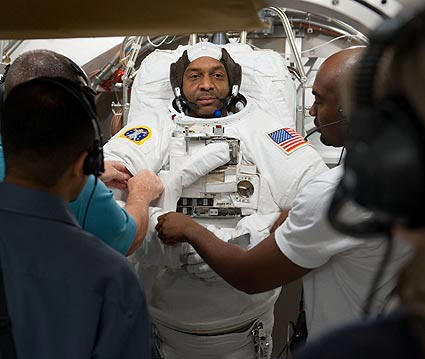
NEWSROOM
 |
NEWSROOM |
|
|
|
||||
|
By Mike Mitchell |
||||
 |
October 30, 2009,
NASA's space
shuttle Atlantis is targeted to begin an 11-day flight to the
International Space Station with a Nov. 16 launch from the
The Nov. 16 target
date depends on the planned Nov. 14 launch of an Atlas V rocket from
nearby Cape Canaveral Air Force Station. The Atlas has reserved the The STS-129 mission will focus on storing spare hardware on the exterior of the space station. The flight will include three spacewalks and install two platforms on the station's truss, or backbone. The platforms will hold spare parts to sustain station operations after the shuttle fleet is retired. Commander Charlie Hobaugh and his crew of five astronauts are scheduled to arrive at Kennedy at approximately 5 p.m. on Thursday, Nov. 12, for final launch preparations. |
|||
|
Image above: STS-129 Mission Specialist Robert L. Satcher Jr.
participates in an Extravehicular Mobility Unit, or EMU, spacesuit fit
check in the Space Station Airlock Test Article in the Crew Systems
Laboratory at NASA's |
||||
|
Joining Hobaugh on STS-129 will be Pilot Barry Wilmore and Mission Specialists Leland Melvin, Randy Bresnik, Mike Foreman and Bobby Satcher. Nicole Stott, an astronaut who currently resides on the station, will return home with the Atlantis crew after living in space for more than two months. Her return on the shuttle is slated to be the final time it is used to rotate space station crew members. STS-129 will be Atlantis' 31st mission and the 31st shuttle flight dedicated to station assembly and maintenance. |
||||
|
Space Shuttle Atlantis (Orbiter Vehicle Designation: OV-104) is one of
the three currently operational orbiters in the Space Shuttle fleet of
NASA, the space agency of the
Atlantis is named after a two-masted sailing ship that operated from
1930 to 1966 for the Woods Hole Oceanographic Institute. The 460-ton
ketch was the first
Space shuttle Atlantis lifted off on its maiden voyage on October 3,
1985, on mission STS-51-J, the second dedicated Department of Defense
flight. It flew one other mission, STS-61-B, the second night launch in
the shuttle program, before the Space Shuttle Challenger disaster
temporarily grounded the shuttle fleet in 1986. Atlantis was used for
ten flights between 1988 and 1992. Two of these, both flown in 1989,
deployed the planetary probes (Magellan to Venus on STS-30 and Galileo
to Jupiter on STS-34).
During another mission, STS-37 flown in 1991, Atlantis deployed the
Compton Gamma Ray Observatory. Beginning in 1995 with STS-71, Atlantis
made seven straight flights to the former Russian space station Mir as
part of the Shuttle-Mir Program. When linked, Atlantis and Mir together
formed the largest spacecraft in orbit at the time.
The first mission flown by Atlantis after the Space Shuttle Columbia
disaster was STS-115, conducted during September 2006. The mission
carried the P3/P4 truss segments and solar arrays to the ISS. On ISS
assembly flight STS-122 in February 2008, Atlantis delivered the
In May 2009 Atlantis flew a 7 member crew to the Hubble Space Telescope
for its Servicing Mission 4, STS-125. The mission was a success, with
the crew completing five space walks to install new cameras, batteries,
a gyroscope and other components to the telescope. The longest mission flown using shuttle Atlantis to date is STS-117 that lasted almost 14 days in June 2007. Atlantis is not equipped to take advantage of the Station-to-Shuttle Power Transfer System so missions cannot be extended by making use of power provided by ISS. |
| ©AvStop Online Magazine Contact Us Return To News |